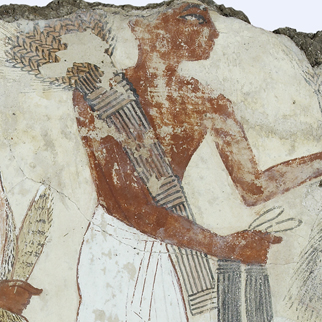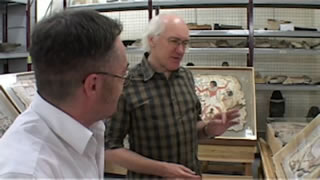1.1 A man of wealth
Another factor that provides a clue to Nebamun’s status is the importance of grain at this time (Figure 5). Egypt was a barter economy. The idea of money in the form of coinage had not yet been invented. Grain was its nearest equivalent. Workers were paid in grain, which would then be exchanged for equivalent values of staples such as foodstuffs, including bread and beer, clothing and other necessities. So Nebamun’s job situated him at an important junction in Egyptian institutional life, where the fundamental stuff of day-to-day existence touched the world of the gods.

Whatever the circumstances of his early life, which are completely unknown to us, by the time he had achieved the status described in his tomb decorations, Nebamun would have been wealthy – one of the top 5% of Egyptian society. A considerable portion of that wealth was probably invested in planning and making the tomb in the Theban necropolis that would be the gateway for his life in eternity. All that we have is ruins and fragments, but in 1350 BC this would have been a considerable enterprise: carving passageways and two rooms out of the solid rock, decorating them with paintings, texts and sculptures, and building an imposing entrance and courtyard.
Watch this video in which Richard Parkinson and Paul Wood talk about Nebamun.

Transcript
The tendency of modern popular myth is to summon up images of secrecy and tomb-robbers, searching for caches of gold by candlelight, and making off in the dark. But historically, Egyptian burials were highly public affairs. The tombs would have been planned for years and worked on for many months. After the funeral, the chapels remained open. They were there for family and other visitors to make their devotions during important festivals, and to keep alive the memory of the deceased – not least to ensure his continued prosperity in the afterlife.
It goes without saying that Nebamun could not have imagined the afterlife he actually got: a star attraction in the British Museum, the object of millions of gazes, his image as well as those of his wife, his children and his cat endlessly reproduced in the vast constellation of Egyptiana along with Tutankhamun and the pyramids: notepads, pencil cases, shoulder bags and mugs. Yet of Nebamun the man, beyond his name and the title of his job, we know nothing.
If you wish to get a sense of the fragmented nature of these tomb-chapels click the link below to explore the tomb-chapel of Senneferi at Thebes and view an excavation conducted by Nigel Strudwick.
Explore the tomb-chapel of Senneferi [Tip: hold Ctrl and click a link to open it in a new tab. (Hide tip)]
